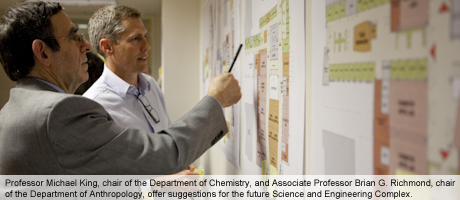Plans for the future Science and Engineering Complex moved ahead this week, as university officials filed an application for zoning approval from the D.C. Zoning Commission and GW faculty members met to provide further input on the building’s interior spaces.
The zoning application for the state-of-the-art facility was filed on Monday. The new complex—to be located on the site of the existing University Parking Garage, at 22nd and H streets, NW—received a unanimous green light by the GW Board of Trustees in mid-October, and will nearly double space for science and engineering research and study.
The building’s eight stories above grade and six below (four of which will be for parking) will provide space for teaching and research laboratories for GW’s Columbian College of Arts and Sciences and the School of Engineering and Applied Science. The School of Medicine and Health Sciences, among other schools and departments, also will be involved in research there.
The design includes a variety of sustainable elements that will target silver-level certification from the U.S. Green Building Council’s Leadership in Energy and Environmental Design (LEED) rating system.
The site, as well as the building project’s basic parameters (like height and size), were approved by the D.C. Zoning Commission as part of GW’s 2007 Foggy Bottom Campus Plan. This week's building-specific filing will be the basis for public hearings and then a final decision by the commission.
The full filing to the commission from Monday is available on GW’s Neighborhood website.
Pending approval by the commission, project construction is anticipated to begin in mid-2011 with a projected completion date in late-2014. University officials say the University Parking Garage will remain in service at least through 2011 commencement and they are actively working to develop transition plans for existing parking customers. The transition plan is expected to be released in early 2011.
The university has begun offsetting the removal of the University Parking Garage’s 1,252 parking spaces by adding 178 parking spaces at South Hall (which was completed in fall 2009), and 362 parking spaces (or 462 when including valet parking) that will become available at Square 54, upon its completion in spring 2011.
Planning and site work also has begun on an underground parking facility and Law Learning Center on the 2000 block of G Street, which will provide approximately 450 parking spaces upon its completion in mid-2012. Furthermore, the Science and Engineering Complex itself will provide up to 400 below-grade parking spaces.
During the transition period, accommodations will be made for daily parking on campus for patients and visitors of the GW Hospital and area medical facilities, as well as 24-hour on-call medical staff with parking needs.
As parking spaces are being completed at the Law Learning Center and the Science and Engineering Complex, the university plans to offer temporary offsite parking for GW staff at a discounted rate at The Kennedy Center, with shuttle service offered to and from GW’s Foggy Bottom Campus.
Meanwhile, on Tuesday, project architects from Ballinger held one in a series of forums with faculty members, and provided a floor-by-floor overview of the proposed layout for teaching and research labs, offices and other spaces.
After the presentation, faculty members were invited to use Post-it Notes to pepper the floor plans with suggested changes for designers to consider as plans move ahead.
Comments ranged from requesting a stock room near a chemistry lab; to positioning a geotechnical engineering lab closer to teaching space; and explaining that some labs can’t have windows, like those involving light-sensitive experiments.
The Post-its also sparked a discussion about plans for creating interdisciplinary research “neighborhoods” in the new building, in which researchers would be grouped by types of research and the equipment they’ll be using.
“I like these forums because everything’s sort of above-board,” said physics Professor Gerald Feldman, who was among the 15 or so faculty members in attendance.
Doing research in Corcoran Hall (which was built in 1924) “is no picnic,” he said. The faculty forums have been a way to draw on the wisdom and experience of the faculty, he said, in helping the architects ensure the new complex will sufficiently meet the needs of researchers over the next 50 years or more.
“You don’t want the building to become obsolete the moment you walk into it,” he said. “So I like the idea that they have these forums and are receptive to these opinions.”
Among them, Dr. Feldman has been a proponent of elements in the building that would attract a diverse swath of people—even something akin to a coffee shop—and would invite random mixing and, perhaps, unforeseen collaborations.
Beyond that, building-in opportunities for science outreach—perhaps exhibit space, a screen for films, areas for lectures—could help position GW as a science destination in D.C., he said, and maybe even pique the interest of non-science majors at the university.
At one university he’d heard about, Dr. Feldman said the new science building became a magnet for students studying everything from sociology to Chinese, who would show up there to do their homework, simply “because it was a nice place to be.”
Putting science on display, he said, could open doors for students who wander in. “Who knows how many students get switched over to science because they think it’s pretty neat?”


